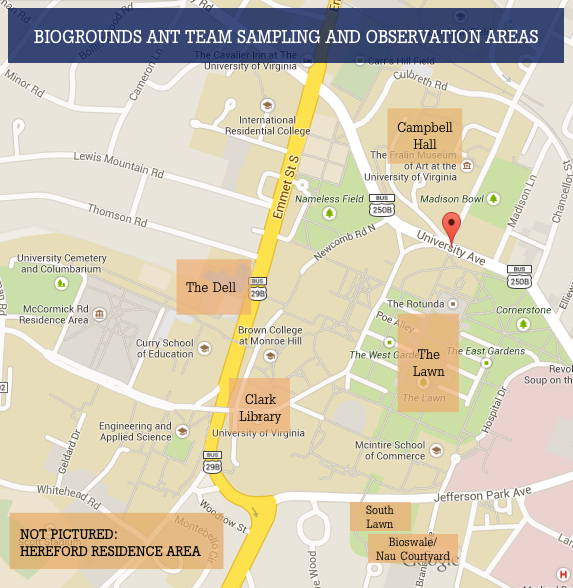Ants- they’re incredibly prevalent in the environment around us. Yet the community around Grounds is more likely to have listened to the old hit song “Ants Marching” by local favorite Dave Matthews than they are to have considered the capabilities, species, and dwelling places of ants around Grounds. These critters, typically about half the size of a paper clip (depending upon the species), are truly impressive. They can lift and carry up to three times their body weight. Some species create foods traps from plant fibers. Others even prey on reptiles, birds, or small mammals. Amazingly, some even go so far as to use young brood – young ants in larval or pupal form – as “rafts” or “life-preservers” during floods. (These fire ants make the raft themselves to save their young and their queen: http://video.nationalgeographic.com/video/animals/bugs-animals/ants-and-termites/weirdest-fire-ant-raft/)
The typical ant, however, lives in a structured, nest-like community located underground, in a mounds, or in a tree, and it functions as part of a swarm. The nest is ruled by the queen, who lays thousands, if not millions, of eggs throughout her lifetime. Other female ants are considered the “worker” ants– they forage, protect, build, and so on. The males typically have just one role in the colony, or army, as a community of ants is known- to mate with the queen. After mating, the male usually dies.
Besides some of the more universal facts about ants, though, we need to gain a specific understanding of where ants live around Grounds and how different habitats may affect species or even food preference. Amy Savage, an entomologist from NC State University (www.ecologyofmutualism.com), visited Ground for the Biophilic Cities Launch last year and found 13 species of ants just around the School of Architecture. Our team wants to spread that study out over many parts of Grounds to gain a better understanding of ant life on Grounds.
But how do we do it? Well, in a study of ant life in New York City, Savage sampled ants in various habitats (parks, forests, and street medians) and noted that each area had unique species of ants. In addition, after giving ants several different food items, including olive oil and sugar water, Savage noted that ant food preference changed by location. Her team saw that ants living in street medians tended to go for the olive oil (higher in fat) because most fat in ant diets comes from other bugs, and many other bugs can’t survive in street medians.
So, with Savage’s work in mind, the Ant Team is preparing its own samplings and observations of ant life as the snow retreats from Grounds. Specifically, we plan on conducting sampling and observations at the following locations:
We plan to sample and observe ant life around hard surfaces, on grassy surfaces, and near trees (where applicable) in these areas. Additionally, as part of our sampling procedure, we plan on using different types of food bait, similar to Savage’s design in her research of ant life in NYC. We look forward to sharing our observations and insights with you as the semester progresses!
References
http://animals.nationalgeographic.com/animals/bugs/ant/
http://www.yourwildlife.org/2014/02/amy-savages-take-on-ants-in-the-big-city/
http://www.ecologyofmutualism.com/
Post by Stephen Brand, Fourth-Year, Commerce
